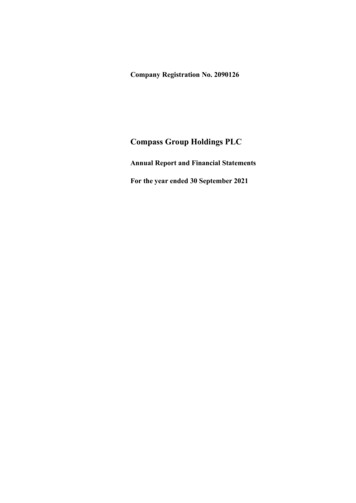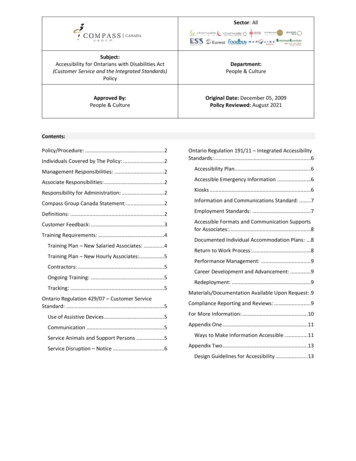
Transcription
COUNTRY COMPASS% AFGHANISTANKilling heroin with saffronWeaning Afghanistan’s poppy farmers awayfrom growing the raw material for the bulkof the world’s illicit heroin has never beeneasy, but Kashmir’s saffron cultivators mayhave the answer. A high-value crop, saffronhas long been seen as a counter-narcoticscandidate, but the idea has a chance ofcoming to fruition with expertise fromfarmers in India’s Jammu and Kashmir statewho produce the finest saffron anywhere.An agreement between the agricultureministries of the two countries paved the wayfor a 25-member delegation from Afghanistanto visit Jammu and Kashmir in November 2011and see how the state’s success with saffroncan be emulated.After touring Pampore, the main centre ofthe saffron industry, located 14 km east ofSrinagar, delegation chief Naseem Atai toldIPS that he was hopeful of a “change of choice”in his country. “Once our farmers grow saffronin the manner of their Kashmiri counterparts,they will certainly find it a profitableagricultural activity and they may ultimatelygive up growing poppy,” Atai said. “We haveseen how Kashmiri farmers are earning gooddividends by growing saffron. We can do thesame for Afghanistan if we adopt the samemethods and techniques.”Afghan farmers, said Atai, have alreadybeen growing saffron since 2000 in Heratprovince near the border with the IslamicRepublic of Iran, “but the yield and quality arenot good since the farmers have no expertiseor access to good technology”.The Islamic Republic of Iran and Spain arethe two other countries where saffron is grown,with Iran producing 85 percent of the world’ssupply. Yet the quality of Kashmiri saffron –essentially the dried stamen of the flower – isconsidered to be far superior to that grownelsewhere in the world.Saffron is sought for the aroma, colour andflavour it gives to rice and other food. It has alsobeen used for centuries in medicines and as anatural pigment. Depending on the variety,some 400 000 or more stigmas may go intomaking 1 kg of saffron. The work must be doneby hand and, since it calls for nimbleness, theindustry holds out employment prospects forlarge numbers of women.Saffron is considered the world’s costliestspice, and Kashmiri varieties currently fetchUS 3 600/kg, although prices in recent yearshave gone as high as US 6 000/kg.Support from India to prop up varioussectors of Afghanistan’s economy wasformalized under a “strategic partnershipagreement” signed in New Delhi during a visitby Afghan President Hamid Karzai in the firstweek of October 2011. This agreement cameeven as the United Nations Drug ControlAgency released the report of a survey thatshowed land under poppy cultivation inAfghanistan increasing as a result of risingopium prices on the one hand and economichardships faced by Afghans on the other.According to FAO, while Afghanistan’s NationalDrug Control Strategy aims to eliminate illicitopium poppy cultivation by 2013, the UN surveyfound that poppy is now grown in 17 of thecountry’s provinces. “Cultivation of poppy hasdevastated our agriculture and reputation. Ourcountry is now known more for poppy andconflict than for any positive activity. We want tochange that,” said Asadullah Aurakzai, amember of the delegation. (Source: IPS in RealChange News, 25 January 2012.)45planting initiatives in towns and villagesthroughout Armenia, an expansion ofreforestation programmes in northernArmenia, maintenance of recently plantedforests, environmental educationprogrammes that train teachers andinspire youth, and community training insustainable forest management. (Source:Armenia Tree Project press release,14 March 2012.)FOR MORE INFORMATION, PLEASE CONTACT:Armenia Tree Project, 65 Main Street,Watertown, MA 02472, United States ofAmerica. E-mail: info@armeniatree.org;www.armeniatree.org/% ANGOLAEnvironment Ministry to create supervisionbodyThe Angolan Environment Ministry,supported by its partners, will soon create anational environment controlling body tomanage the country’s parks. “This will beimplemented under the policies andgovernment programmes aiming atimproving control and management actionsin the conservation areas, mainly in thenational parks, where ecotourism needs tobe promoted,” said the Environment Minister,Maria de Fátima Jardim.The project started with a group of 45former military personnel selected in thenorthern Cabinda province, who said they areready to learn techniques to enable them totake care of Mayombe Forest, mainly itsnational park. (Source: Angola Press, 9February 2012.)% ARMENIANorwegian Ministry of Foreign Affairsmakes major commitment to ArmeniaTree ProjectYerevan. In recognition of Armenia TreeProject’s successful record in tree planting,environmental education and sustainabledevelopment, the Norwegian Ministry ofForeign Affairs has awarded it a US 1.2million grant. The Norway funding willprovide partial support for some of theproject’s core programmes, including tree% AUSTRALIAACIAR'S forestry research in Pacificisland countriesThe Australian Centre for InternationalAgricultural Research (ACIAR)’s mainstrategies in the Pacific islands have beento focus on research that supports thegrowing of high-value trees by landowners,developing value-adding opportunities fortimber and non-timber products, and theprotection of plantations from insects anddiseases.Forests and trees have great culturalsignificance for Pacific island people andprovide many benefits for subsistence andlivelihoods. In some of the Pacific islandcountries, such as the Solomon Islands,Vanuatu and Fiji, forests have also beencommercially exploited and forest industriesare important contributors to the nationaleconomies. Forests are held under customlandownership, but governments regulatecommercial forestry operations. Whiletimber is important, there are many NTFPsthat provide significant cash income forpeople in remote locations. Nuts fromCanarium trees are an important, locallytraded NTFP in the Solomon Islands andVanuatu. Sandalwood (SantalumNON-WOOD NEWS No. 24 May 2012
COUNTRY COMPASS46austrocaledonicum) has been traded forcenturies and is still a very important forestproduct in Vanuatu. (Source: Tony Bartlett,Forestry Research Program Manager,Australian Centre for InternationalAgricultural Research.)% BANGLADESHImproving livelihood status throughcollection and management of forestresourcesA recent paper explored the role of forestresources in improving the livelihoods offorest-dependent people in and around twoforest ranges in Sylhet Forest Division. Theauthors conducted an intensive field surveyfrom early May to mid-August 2010,collecting primary information throughcommunity profiles and householdinterviews, using a semi-structuredquestionnaire focusing onsociodemographic, livelihood activities andoverall impacts on forest resources. A totalof 58 respondents from two forest ranges(36 from Kulaura and 22 from Habiganj-2range) were interviewed.Data analyses show that overall, 26 and33 percent of people respectively in the tworanges, are totally dependent on the forestfor their livelihoods. About 42 plant speciesbelonging to 32 families were used by thepeople. Of these species, trees dominated(50 percent), followed by herbs(29 percent). Collecting forest resources,especially NTFPs and building materials,helps people meet important householdneeds and are sources of income – such asleaves and medicinal herbs, food forlivestock, fruits, fuelwood and honey –while also supporting the production ofsecondary goods such as processed orprepared food (animal and vegetable),baskets and other crafts.The paper concludes that research onthe use of forest resources and comanagement practices should beimplemented through forest-dependentpeople to continue to live in and around thestudy areas in a sustainable manner.(Source: Improving livelihood statusNON-WOOD NEWS No. 24 May 2012through collection and management offorest resources: an experience fromSylhet Forest Division, Bangladesh. InInternational Journal of Forest UsufructsManagement, 12(2), July–December 2011.)FOR MORE INFORMATION, PLEASE CONTACT:Most. Jannatul Fardusi, Md. Habibur Rahmanand Bishwajit Roy, Department of Forestry andEnvironmental Science, School of Agriculturaland Mineral Sciences, Shahjalal University ofScience and Technology, Sylhet 3114,Bangladesh. E-mail jfardusi@yahoo.com/% BENINEthnic differences in use values and usepatterns of Parkia biglobosa in northernBeninThe African locust bean tree (Parkiabiglobosa) is a multipurpose species usedwidely in arid Africa by local communities.The present study focused on ethnicdifferences in use values and use patterns ofP. biglobosa in northern Benin, where thespecies grows widely. The use valuesaccording to the various ethnic groups in thestudy area have been evaluated in detail.From 13 ethnic groups, 1 587 peoplewere interviewed in the study area usingsemi-structured questionnaires. Allinterviewees in the study area knew at leastone use of P. biglobosa. The various usesidentified were medicinal (47 percent),handicraft and domestic (3 percent),medico-magic (1 percent), veterinary(1 percent), cultural (1 percent), food (25percent) and commercial (22 percent). Thevarious parts involved in these types ofuses were: fruits (shell [2 percent], pulp[22 percent] and seeds [36 percent]), bark(17 percent), leaves (9 percent), roots(3 percent), flowers (1 percent) andbranches (10 percent). The ethnic groupconsensus values for P. biglobosa partsshowed that the seeds are used the most.The study concluded that P. biglobosa iswell known and used in different ways bythe local populations in the study area.Local knowledge on the species isdiversified and influenced by ethnic group.Ethnic differences in use values and usepatterns of the species were evident in thisstudy. (Source: K. Koura, J.C. Ganglo, A.E.Assogbadjo and C. Agbangla, C. 2011.Ethnic differences in use values and usepatterns of Parkia biglobosa in NorthernBenin. Journal of Ethnobiology andEthnomedicine, 7: 42.)Bénin: quand les dieux préservent lesforêts(Syfia Bénin.) Le Bénin conserve encoreprès de 3 000 forêts sacrées, réservoirs debiodiversité et remparts contre ladésertification. Bientôt intégrées dans lesaires protégées, elles contribuent à leurpréservation, en dépit de pressionscroissantes.À Ouidah, capitale économique du Béninsituée à 40 km de Cotonou, un lopin deforêt oppose encore une résistance à unecité en pleine urbanisation. Dans la partiede la forêt accessible au public, de petitescases décorées de dessins de serpents etdes amulettes accrochées aux pieds degrands arbres alertent le visiteur qu’il setrouve en un lieu habité par les esprits.Nous sommes dans la forêt sacrée deKpassè. «Cet endroit est sacré parce quec’est ici que se trouve l’esprit du roi Kpassèqui, disparu en 1661, s’est transformé enarbre», raconte Anicet Zantchio, guide danscette forêt érigée en site touristique. «Nousavons décidé d’ouvrir une partie dudomaine au public à la demande duGouvernement. En principe, seuls lesinitiés sont autorisés à se rendre dans cetteforêt où nous organisons les cérémoniesrituelles, en particulier l’enterrement descrânes des défunts de notre lignée», ajouteGédéon Kpassènon, membre de la familleroyale de Ouidah qui assure la gestion de laforêt.Le Bénin, terre du vaudou, regorgetoujours de réserves boisées conservéespar les gardiens de la tradition, en grandemajorité de petits îlots forestiers éparpilléssur le territoire. Une récente étude arépertorié 2 940 forêts sacrées et autresplantations «déifiées», abritant divinitéstutélaires, sociétés secrètes ou cimetières,pour une superficie totale d'environ 18 360hectares.Rempart contre la désertificationMême si les forêts sacrées sontprioritairement consacrées aux rituelsvaudou, elles constituent, aux yeux denombreux spécialistes, la formetraditionnelle par excellence de conservationdes écosystèmes. «Leur gestion et leuraccès, indique Nestor Sokpon, enseignant ensciences agronomiques à l’Universitéd’Abomey-Calavi, sont réglementés par desprincipes religieux qui se matérialisent àtravers tout un ensemble d’interdits, deprescriptions et de pratiques rituelles qui ontlongtemps permis leur protection et leurrégénération». La réglementation de l’accès
COUNTRY COMPASSau lieu et à ses ressources ont souventrepoussé les propensions humaines à leurdestruction. «Nos parents avaient descoutumes pour préserver les écosystèmes,forêts, marigots, etc. Quand ils sentent lapression démographique, ils implantent unfétiche pour faire reculer l’activité humaineet garantir un certain équilibreenvironnemental», souligne Ferdinand Kidjo,directeur technique du Centre national degestion des réserves de faune (CENAGREF).L’importance de ces forêts dans lapréservation de la biodiversité est beaucoupplus forte dans le Nord du pays, où les ritesd’initiation en forêt sont encore légion. «Laconservation des forêts à des fins initiatiquesconstitue un vrai rempart contre ladésertification, très avancée dans cetterégion du pays», atteste Ferdinand Kidjo.Pour lui, ces forêts sont comme un réelinstrument d’adaptation au changementclimatique. «Si on les regarde, renchéritÉvariste Alohou, coordonnateur du projetd’intégration des forêts sacrées dans lessystèmes des aires protégées du Bénin, on yretrouve des espèces végétales quin’existent plus nulle part ailleurs. Ellesregorgent d’une biodiversité que nous neretrouvons plus dans les végétationsexploitables.»Il faut sauver la forêtMais la force des esprits qui préservaientautrefois l’intégrité de ces surfaces boiséessemble s’effriter au fil du temps. «La forêtsacrée de Kpassè couvrait une superficie de360 hectares, aujourd’hui elle est confinéedans un périmètre de 4 hectares parce que ledomaine a été morcelé au profit deshabitations», se désole Gédéon Kpassènon.Évariste Alohou constate que beaucoup deforêts sont aujourd’hui menacées dedisparition, car confrontées à unedégradation avancée face à des pressionsdémographiques et économiques, liéessurtout au recul du pouvoir des religionstraditionnelles. «Les gens croient de moinsen moins aux esprits des forêts sacrées, quicommencent à faire l’objet d’une exploitationfrauduleuse», affirme-t-il. Ferdinand Kidjoestime, pour sa part, que l’absence desforêts sacrées dans le système national desaires protégées a contribué à leurdégradation.Conscient du péril, l’État béninois a lancéen 2010 le projet d’intégration des forêtssacrées dans le système des airesprotégées. «Il s’agit pour nous de développerdes aires communautaires, de promouvoirun système d’utilisation durable et d’étendreles principes de bonne tenue de ces forêtssacrées et de leur environnement», affirmele coordonnateur du projet financé par leFonds pour l’environnement mondial (FEM).En attendant de passer la main au Codeforestier national, les esprits gardenttoujours le contrôle sur ce qui reste desforêts sacrées contre la convoitise humainede plus en plus pressante. (Source: SyfiaInfo, 22 décembre 2011.)% BHUTANLocals worry over sustainability of bamboosupplySephu Geog, an area once providing anabundant bamboo harvest, is now facing ashortage in its supply as demand forbamboo handicrafts has increased. Thedemand for bamboo has also doubled as aresult of the booming constructionindustry, which is struggling to findalternatives for timber. (Source: HeadlinesHimalaya, 188, 26 December 2011.)% BURKINA FASOEmpowering women for better trade in sheaShea is one of the main forest products inthe Sahel zone of West Africa and shea nutsand butter represent a significant source ofincome for rural communities in Benin,Burkina Faso, Côte d’Ivoire, Ghana, Mali,Nigeria, Senegal and Togo. The trees grownaturally throughout the semi-arid region ofWest Africa, but their largest concentrationis in Burkina Faso, where exports of sheaproducts accounted for the country's thirdmost important export in 2000. Shea butter– often termed as “women’s gold” byvillagers in Burkina Faso – is extracted fromthe kernel through arduous processing, andis the exclusive prerogative of rural women,who are also totally involved in the collectionof shea nuts.With communally owned woodedsavannahs comprising approximately half of47the landscape, shea has emerged as a vibrantsector for local economic development andsustainable forest management in BurkinaFaso. The growing demand for cooking andcosmetics uses, both for domesticconsumption and export, has further fosteredthis strong growth in recent years.The improved economic condition of theshea trade, however, has not equitablybenefited the women who have toiled themost. While women’s participation hadremained restricted to local markets, mencontinued to dominate the lucrative exportmarkets, resulting in a very unfair situationfor women. Low literacy levels, lack oftechnical skills and poor access to marketinformation and formal credit have furtheraggravated their plight.In response to these changes, particularlyafter structural adjustment had negativelyimpacted the livelihoods of numerous poorfamilies, the Government of Burkina Faso andother national and international organizationstook several initiatives. The key focus of thesemeasures has been the development of theshea sector through the empowerment ofwomen engaged in this enterprise. Some ofthese initiatives include launching the Projetnational karité (PNK, National Shea Project),with financial and technical assistance fromthe Centre canadien d'étude et de coopérationinternationale (CECI, Centre for InternationalStudies and Cooperation); mobilization offunding support from Taiwan Province ofChina; monitoring of exports by the UnitedNations Development Fund for Women(UNIFEM); and the establishment of acoordinating committee by the government toensure synergy among various donorinstitutions. The support of UNIFEM, forexample, ensured direct purchases through anetwork of more than 100 shea groups thathave been set up and a greater share ofbenefits for local women engaged in theindustry. The women were also trained in thetrade, in order to produce a better-qualityproduct.The empowerment of women through theorganization of local shea cooperatives,besides creating better economicopportunities for women producers, hashelped them earn the respect of their familyand provide new opportunities for theirinvolvement in community development.(Contributed by: Jagannadha Rao Matta,Ph.D., Forestry Officer (Finance), ForestEconomics, Policy and Products Division,Forestry Department, FAO, Viale delle Termedi Caracalla, 00153 Rome. Fax: 390657055137; e-mail: Rao.Matta@fao.org/)NON-WOOD NEWS No. 24 May 2012
48% CAMEROONPromoting sustainable medicinal wildlifeuse in CameroonAs the first phase of a two-prongedcommunity education project, “Promotionof the sustainable use of indigenouswildlife resources as medicinal wildlife, inCameroon’s Northwest Region”, a studywas carried out from February toNovember 2010 both to identify wildlifespecies that are used for traditionalmedicine and the means of theiracquisition. The main objective of theproject was to raise public awareness ofthe sustainable use of medicinal wildlifeand the study, a questionnaire survey, wasinitially to establish the fact that wildlifeproducts/parts are actually applied intraditional medical treatment orprevention.To achieve the goal, we set out toadminister questionnaires to 60 traditionalpractitioners in all seven administrativedivisions of the Northwest Region, theproject site. At the end of the field work wehad approached 62 practitioners. Of the61 who responded, two said they did not usewild animals for medicines and could not gointo any detail.From the responses of the 59 traditionalpractitioners, 58 wildlife species –comprising 26 mammals, eight birds, teninsects and two fish – were indicated ashaving medicinal values in 53 cases oftraditional treatment of illnesses and othermedicinal usages. Of the 53 indicatedmedicinal usages, mystical protection,mental ills, disabled children andrheumatism rank in descending order asmost necessitating medicinal wildlife.However, and most important of all, of the58 identified medicinal wildlife species,13 are of “Class A” or “totally protected” inCameroon, one is endemic and 14 are listedunder the Convention on InternationalTrade in Endangered Species of Wild Faunaand Flora (CITES) – banned frominternational trade.Paradoxically, the only wildlife speciesthat are extinct in the Northwest Region –and classified as “totally protected” inCameroon – rank as the first and secondhighly used medicinal wildlife species: theelephant (Loxodonta africana) and the lion(Panthera leo). The chimpanzee (Pantroglodytes) and the African rock python(Python sebae), both of “Class A” inCameroon and listed as “endangered” inthe International Union for Conservation ofNON-WOOD NEWS No. 24 May 2012COUNTRY COMPASSNature (IUCN) Red List, both rank as thethird most used medicinal wildlife species.Furthermore, from the survey, only two ofthe 59 respondents had inherited the wildlifeproducts used, while 13 non-licence-holdingtraditional practitioners hunted the requiredproducts by themselves and the rest affirmedthat they ordered them from local hunters orbought them from the open but secretivebushmeat markets. This was revealing of theunsustainable use of the wildlife products,considering that only one hunter hadobtained and operated with a hunting licencethat year in the Northwest Region. Unless thepractitioners bought their products out of theregion (which was not indicated), most ofwhat they used was illegally harvested.The study result was presented at theBamenda Symposium on SustainableMedicinal Wildlife, held in Bamenda, the chieftown of the Northwest Region on10 November 2010 and presided over by theRegional Delegate of the Ministry of Forestryand Wildlife. During the historic symposium,a medicinal wildlife poster was launched forfree public distribution.Concrete recommendations were made byworking groups for the three stakeholders(the government, NGOs and traditionalpractitioners) for them to take action in theirrespective spheres for the sustainableuse/management of medicinal wildlife.These recommendations were the following.For the government: take the lead in raisingpublic awareness of the sustainable use ofmedicinal wildlife; intensify the protectionof identified medicinal wildlife species;facilitate the obtaining of medicinal wildlifeproducts; and promote research on the useof indigenous wildlife species for traditionalmedicine.For conservation and pro-healthNGOs/groups: carry out research, trainingand community education on thesustainable use of medicinal wildlife; andcreate networking among stakeholders inmedicinal wildlife use/management.For traditional practitioners: researchalternatives to protected medicinal wildlifespecies; seek legal access to medicinalwildlife species; and create networksamong practitioners to use medicinalwildlife sustainably.For the second phase of the sustainablemedicinal wildlife initiative, which isongoing, key activities include: (i) running a“medicinal wildlife quarter hour” bimonthlyradio slot; (ii) production of a short film onsustainable medicinal wildlife, with sceneson wildlife sensitization; (iii) reproduction ofmore medicinal wildlife posters, to raisefurther awareness; (iv) subsidize (by75 percent) the acquisition of huntinglicences by local people to set an examplefor legal access to medicinal wildlife; and (v)train some traditional practitioners to betrainers on sustainable wildlife use.Both phases of the initiative have been orare being realized with funding supportfrom the Rufford Small Grants Foundation,the institutional support of the regionalservices of the Ministries of Forestry andWildlife and of Public Health in theNorthwest Region and of the Centre forIndigenous Resources and Development(CIRMAD), a local conservation NGO.(Contributed by: Emmanuel Liyong Sama,Wildlife and Protected Area ManagementSpecialist, Conservator of Kagwene GorillaSanctuary, PO Box 4081, Bamenda,Cameroon. E-mail: esama cts/emmanuel liyong sama/)La valorisation des PFNL au Cameroun:cas de la forêt communautaire deMorikouali-Ye dans la région de l’EstUne étude menée dans la forêtcommunautaire de Morikouali-Ye a pourprincipal objectif de concilier lacommercialisation des produits forestiersnon ligneux (PFNL) et leur exploitationdurable. De façon spécifique, il s’agit d’unepart, de déterminer le bénéfice que lesménages tirent de la vente des PFNL et,d’autre part, d’évaluer ce que ces ménagessont prêts à payer en vue d'exploiterdurablement ces ressources.L'étude a utilisé la méthode d’évaluationcontingente à travers deux approches, l’uneparamétrique (modèle Logit) et l’autre nonparamétrique (estimateur de la borneinférieure de Turnbull), ainsi qu’un modèleTobit censuré, sur un échantillon stratifié de60 ménages ruraux. Les résultats obtenusont été les suivants:
SPCOEUCNI TA RL YF EC AO TMUPRAESSS L’étude sur la valorisation des PFNL amontré que cinq espèces sont les pluscollectées dans la zone d'étude: Irvingiagabonensis, Ricinodendron heudelotii,Gnetum, le jujube et les écorces. Leurvente contribue significativement à41 pour cent du revenu total desménages. Cette part est fortementinfluencée par le nombre de personnesdu ménage, l’âge, le niveau d’instruction,le temps passé à la collecte etl'emplacement dans la forêtcommunautaire. Elle diminue en outreconsidérablement du fait del’augmentation de la population et de lamauvaise exploitation de la forêt. Quelque 68 pour cent des ménagesinterrogés sont disposés à payer pourgarantir une exploitation durable desPFNL, en vue de profiter de l’usage de cesressources et de conserver les revenusqu’ils tirent de leur vente. L’estimation duconsentement moyen à payer par lemodèle Logit et par l’estimateur deTurnbull est respectivement de l'ordre de6 845 FCFA et 4 940 FCFA par ménage etpar an, avec un coût social de ladégradation évalué à 3 237 820 FCFA l’an.La probabilité du paiement augmenteavec le revenu, le sexe, le nombre defemmes dans le ménage, l’âge et l’activitéen tant que commerçant de PFNL, etdiminue avec l'argument dudéveloppement durable.(Auteur: Sophie Michelle Eke Balla, s/c TitaIsaac, B.P. 11507, Yaoundé, Cameroun.Courriel: sophiemichelle2002@yahoo.fr ouekesophie@gmail.com/)AFRICAN% CENTRALREPUBLICContribution à l’inventaire ethnobiologiquedes champignons comestibles en vue d'unessai de domesticationLa République centrafricaine dispose d'unmassif forestier important et d'une savaneétendue sur tout le territoire. À l'instar dubois, les produits forestiers non ligneux(PFNL) contribuent considérablement auxmoyens d'existence des populations urbaineet rurale riveraines. Ces PFNL sont variés etrépandus sur toute la superficie, tant en forêtqu’en savane. Pratiquée par plus de la moitiéde la population, leur cueillette contribue àl’alimentation, sert au traitement de certainesmaladies et génère des revenus.Parmi les PFNL, les champignonscomestibles sauvages offrent un attraitparticulier du fait de leur saveur et de leurvaleur alimentaire et commerciale. Ilsconstituent en effet un aliment completcontenant des minéraux, des glucides, desprotéines et des lipides. Certains chercheursont étudié l'apport alimentaire deschampignons comestibles sauvages,parvenant à des résultats intéressants,comme l'illustre l'exemple de Auriculariacornea séché – valeur énergétique:397 kilocalories pour 100 grammes;composition chimique moyenne enpourcentage: protéines, 7,9; lipides, 1,2;vitamine B12, 2.10-4; fer, 64,5.10-3.L'étude et la conservation de ceschampignons constituent un axe de rechercheprioritaire pour la sécurité alimentaire et lalutte contre la pauvreté en Républiquecentrafricaine. Ainsi, à travers le projetGCP/RAF/441/GER «Renforcement de lasécurité alimentaire en Afrique centrale àtravers la gestion durable des produitsforestiers non ligneux» mis en œuvre par laFAO, une étude ethno-mycologique a étémenée sur les marchés de Bangui et desenvirons.L’objectif était de collecter les diversesespèces de champignons comestibles,recueillant leurs noms vernaculaires et leurssubstrats, voire leurs habitats, en vued'effectuer un essai de domestication et demontrer leur importance pour la sécuritéalimentaire des populations urbaine et rurale.Une analyse conduite par la suite enlaboratoire devait déterminer lescaractéristiques organoleptiques deschampignons. Il s'agissait en outre d'estimer,en termes de commercialisation, lacontribution de ces produits dans l’économielocale des ménages, les femmes en étant lesprincipales vendeuses sur tous les marchés.Par ailleurs, l'étude visait à renforcer lescapacités de tous les acteurs impliqués dansla filière.Cette étude a permis de recenser leschampignons comestibles et d’établir lacorrespondance entre leurs nomsvernaculaires et leurs noms scientifiques.49Ainsi, Termitomyces stratus s’appelle gougouti bobo, gougou champignon et bobo termiteen sango, et Termitomyces spp. se dénommengawe (jeune fille) en yakoma. L’étude amontré que les populations sont de grandesconsommatrices de champignons, chaqueethnie détenant des connaissancesmycologiques variées et en faisant un usagedivers. Ces différences portent tant sur lanomenclature locale que sur laconsommation, l’utilisation médicinale et lesmodes de préparation. (Auteur: Yolene RelleaKouagou, stagiaire à la FAO dans le cadre duprojet PFNL, s/c FAO B.P. 2157, Bangui,République centrafricaine. Courriel:kouagou 86@yahoo.fr/)(Please see pages 67–68 for more informationon this project.)Commercialisation de Gnetum spp. dans laLobayeLa préfecture de la Lobaye en Républiquecentrafricaine est une zone très riche enproduits forestiers non ligneux (PFNL) telsque Irvingia gabonensis (mangue sauvage),Gnetum spp. (koko), Pentaclethramacrophylla (ebai) ou Ricinodendronheudelotii (essessang). Les communautésautochtones Aka, principales bénéficiaires deces PFNL, représentent 30 à 40 pour cent dela population de cette zone. Ce sont degrandes collectric
COUNTRY COMPASS NON-WOOD NEWS No. 24 May 2012 45 AFGHANISTAN Killing heroin with saffron Weaning Afghanistan's poppy farmers away from growing the raw material for the bulk of the world's illicit heroin has never been easy, but Kashmir's saffron cultivators may have the answer. A high-value crop, saffron has long been seen as a counter .










